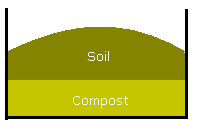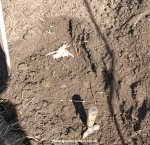Categories
Calendars
Guides
Reviews
Archive
Gallery
Articles
Ask Our Gardening Expert
How to Grow Asparagus
Asparagus was first grown around 500BC in Greece. Its primary use in those times was as a medicine. Almost a crime, I know, but the Greeks disposed of the stem and used the roots only.
Asparagus is said to be good for helping urinary tract infections, kidney stones and to help liver problems. In my view they missed the point, it's delicious to eat!
Asparagus (Latin name Asparagus officinalis) is a hardy perennial with all parts being edible. We eat the stalks which are know as spears. When sown from seed they take 3 years to produce a crop, two years when grown from a 1 year old crown. Each plant will produce approximately 25 spears each year. Asparagus plants will continue to crop for around 20 to 25 years. If you want to know some interesting facts about asparagus click here.
Cultivation of asparagus is relatively simple if you follow some basic
rules. Do that and you will have a delicious annual crop of spears which
may well outlive you!
How to Grow Asparagus - Site and Soil
They need a well drained soil that still holds water and they do not like heavy clay or acidic soils. The best soils will have a pH of 6.5 to 7.5. A late frost can damage the crop severely so avoid planting in frost pockets. Asparagus can be grown in partial shade with success but the best results are achieved when they are grown in full sun.
Seed or Crowns?
Asparagus can be grown from seed or one year old plants (known as crowns) can be bought from your local garden centre or nursery. Growing from seed is the cheapest method but it is more time-consuming and it will take you an extra year to get a crop.
On the other hand, asparagus grown form seed will transplant better with an almost zero failure rate. With crowns you can expect around a 10% failure rate.
Asparagus can be grown from seed or one year old plants (known as crowns) can be bought from your local garden centre or nursery. Growing from seed is the cheapest method but it is more time-consuming and it will take you an extra year to get a crop.
This article assumes you have one year old
crowns either bought or grown from seed. If you wish to
grow asparagus from seed click here and
then return to this point.
How to Grow Asparagus - Planting

Prepare the planting area well in advance, autumn is a good time. Dig over the entire area to a spade's depth removing all traces of weeds. If the soil is not well-drained then add some grit or lots of compost.
The crowns should be planted in mid-April. The diagram below shows the best way to plant an asparagus bed. Any planting plan will be OK though as long as the plants are 45cm (1ft 6in) apart.

For each row dig out a trench 25cm (10in) deep by 30cm (1ft) wide. Fill the bottom 8cm (3in) with well-rotted compost then cover with the soil forming a ridge.
The picture on the left shows a lengthways view of the trench with the ridge.

Place crown on the top of the ridge and drape the roots either side. Cover with crumbly soil so that the crown top is 8cm (3in) below the surface.
Asparagus roots spread a long way so
leave free an area of 75cm (2ft 6in) around the edge of planted bed.
Click the picture on the right (planting asparagus) to enlarge
it.
How to Grow Asparagus - General Care
Feed with a general purpose fertiliser in mid-March and then again mid autumn. The asparagus bed should be kept weed free and because they are shallow rooted it's best not to use a hoe. Hand weeding is best. With this in mind it may be best to mulch the area to stop weeds.
As they grow, the plants will need some form of support to avoid wind damage. Stakes along the rows of plants with two tiers of string will be fine.
In autumn when the foliage turns yellow or brown cut the plant down to 5cm (2in) above ground level.
Harvest Asparagus

Don't harvest asparagus for the first two years after the crowns are planted. This will allow a good root system to develop. Opinions vary but normally asparagus is harvested when it is about 15cm (6in) tall. Any taller than this and the skin will start to thicken and it will need to be peeled before eating.
Cut off the shoots with a sharp knife about 2cm (1in) below the soil surface. You'll need to harvest every 3 days or so because asparagus can grow very, very quickly. In warm and moist soil they can grow 15cm (6in) in a day, so daily harvesting may be required when the growing conditions are ideal. Harvest for 8 weeks and then stop. The remaining shoots will enable the asparagus plant to build up the roots.
Eat as soon as possible after harvesting . Asparagus freeze very well.
Asparagus Pests and Diseases
Slugs can be a problem when they eat the young asparagus shoots. For more details on how to control slugs click here.
The other pest that sometimes attacks the foliage is the Asparagus Beetle. The little bugs are about 8mm long, and are black with yellow spots on them. They can be picked off individually in most cases, but if they become too numerous, spray at weekly intervals with derris. These pests over-winter in the soil and debris around the plants so burn any foliage which is cut down in autumn.
Name: andy/gayna
E-mail: andrew@aquine.orangehome.co.uk
Date posted: December 15, 2011 - 02:35 pm
Message: andy/gaynas allotment...question 3
Hi,firstly thanx for your rapid response to our previous questions,very much appreciated.Being totally knew to keeping an allotment our knowledge base is obviously very limited.Therefore we are looking through many websites and books to rectify this however,this at times can be quite confusing as there are many varying opinions.We have decided to stick to one site only and have decided yours is the one < LUCKY YOU > As previousley mentioned we have just taken on a plot and are currently in the process of re-designing and shaping the plot. We have taken down two large raised beds and spread ,turned the soil and addressed the weeds.Of the raised beds we are keeping, several we have decided to start from scratch.These we have dug over and weeded and looking to start next year.As my partner has a horse we have a constant supply of menua,both fresh and rotted.QUESTION....would it be good practice to cover these beds with menua untill next year/in the first instance to keep the weeds down and then 2 weeks before we plan to plant the beds dig the menua in , I assume the nutrients over time will work there way into the soil through natural mechanics, prior to digging it in.
Name: jim@GardenAction
E-mail: webmaster@gardenaction.co.uk
Date posted: December 14, 2011 - 07:00 pm
Message: Cuprinol is a timber preservative and would probably toxic to soil life. It is a good idea to separate the timber from the compost with a membrane, as you suggest. Even if not preserved, it may slow the rotting process anyway.
Name: andy
E-mail: andrew@aquine.orangehome.co.uk
Date posted: December 14, 2011 - 01:25 pm
Message: Hi, i am making compost bins from 5"x1" timber.The bins will be made as individual modules that can be stacked as required.The timber was sourced from old raised beds that had been painted with i believe gloss,. that has faded and now peeling.I have stripped the paint and am going to coat the external side with a shed/fence cuprinol from b+q to prevent rot.My question is can i do the same to the inside or am i better using a membrane of some sort as i dont want to potentially contaminate the compost...thanx Andy
Name: jim@GardenAction
E-mail: webmaster@gardenaction.co.uk
Date posted: December 14, 2011 - 06:47 am
Message: Well, John. The first frost should see off the asparagus tops. Until then,let them photosynthesize as much energy as possible to use for growth next spring.
Name: John A Ziegler
E-mail: Private
Date posted: December 13, 2011 - 09:05 pm
Message: My asparagus is tall and still green. I want to cut it down now and it's getting late in the year, but they are not turning yellow or brown, I guess because we've had a warm autumn. should I cut them? Anyone know?
Name: jim@GardenAction
E-mail: webmaster@gardenaction.co.uk
Date posted: December 12, 2011 - 02:11 pm
Message: You're lucky, the work has been done for you. Treat them like rhubarb or other herbaceous perennial Clear the weeds from around the crowns, feed with compost and see what comes up in spring. If there are a small number of 'spears', leave another year before harvesting.
Name: andy
E-mail: andrew@aquine.orangehome.co.uk
Date posted: December 12, 2011 - 01:07 pm
Message: hi,have just taken on an allotment last week that has been left untentended i believe for a couple of months .The plot consists almost entirely of raaised beds.At present i am digging the beds over and generally starting from scratch.one bed has asparagus in,i dont know the history or timescale of asparagus,my question being where do i start with this asparagus. Any help will be greatley appreciated thanx...andy
Name: lloyd wright
E-mail: wright_vicki@bellsouth.net
Date posted: September 11, 2011 - 02:39 pm
Message: i have first year asparagus ferns do you cut ferns down or will they die or what do you do with the ferns now
Name: Pat Reuter
E-mail: reuter_patricia@hotmail.com
Date posted: September 07, 2011 - 01:30 pm
Message: Is there a way to keep roots over the winter and plant the next spring as I didn't get them planted
Name: Kristina Deerwester
E-mail: fallingstar19811976@yahoo.com
Date posted: August 30, 2011 - 01:17 pm
Message: When is the best time of year to plant asparagus?
Name: Michael Hill
E-mail: michaelhill1066@aol.com
Date posted: August 26, 2011 - 03:18 pm
Message: Hi.Can you please advise me on moving asparagus plants from one area of my allotment to another, when is the best time to do this and will it cause any
damage to the plant.
Thanks Mike.
Name: mary hotchkin
E-mail: mary.hotchkin@btinternet.com
Date posted: August 09, 2011 - 06:38 am
Message: Hi please can you help me We moved into a bungalow this year and to our surprise our garden was full of aspargus. This we have enjoyed for months we have now come to the end and our plants have all gone to fern. What do i do now I would like to move the plants to one area of the garden but don't know the best time to do this and how... HELP I dont want to lose my lovely asparagus as it was wonderful to eat.. thank you mary
Name: THOMAS
E-mail: thomaspoem1@gmail.com
Date posted: August 02, 2011 - 04:41 pm
Message: I am from India. I am very much interested in asparagus .My place is tropical sunny and humid(85%) which variety you suggest.
thanks.
thomas
Name: Ratan
E-mail: Private
Date posted: July 29, 2011 - 12:09 am
Message: hey hi this is ratan here . i am looking for ur asparagus can u plz suggest some one who can supply asparagus in india or some where else . waiting for ur kindly reply.
Name: Roberto Thomas
E-mail: roberto.thomas_hernandez@okstate.edu
Date posted: July 12, 2011 - 01:14 pm
Message: Hi, my name is Roberto Thomas I am a student from the faculty of International Agriculture at Oklahoma State University the reason I contact you is because I am doing a research about asparagus and the international Market, can you advice me with some companies that sell asparagus around the world or at least in the US or Europe?? I appreciate your answer
Name: Rhodri
E-mail: Private
Date posted: July 05, 2011 - 02:18 pm
Message: Hello. Can you grow Asparagus outdoors or only indoors if you can email me at rhodricartref@hotmail.co.uk that will be good.
Thank, you
Rhodri
Name: David
E-mail: Private
Date posted: June 29, 2011 - 11:35 am
Message: amazing website, thanks!
Name: Marianna
E-mail: Mariannarad@gmail.com
Date posted: June 20, 2011 - 02:35 am
Message: my asparagus plants are one year in the groung this year,spring i did get several spears,thin,but edible, i was sick and unable to get out to the garden, now the are tall ferns///what now? how do i attend to them .do they get cut down or do i wait for the fall what now...help!!
Name: Shkumbin
E-mail: Private
Date posted: June 10, 2011 - 07:49 am
Message: We are new in agriculture business, wants to start commercial production of Asparagus.
We have 4 Hectares of land located in 650 m above sea level with temperatures summer up to 39 degree and winter up to -15 degree.
Can you please advice us how many kg we will have from 1 hectares, and do we need lot of water to feed them.
Name: jimit patel
E-mail: Private
Date posted: June 02, 2011 - 04:30 am
Message: we want to grow this plant by airoponics and hydroponics system so is it possible to grow by this metod and if possible than from where we get the explant or shoot as raw material use?
